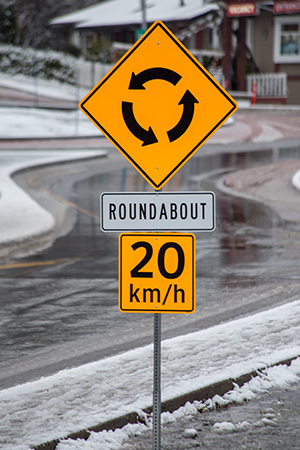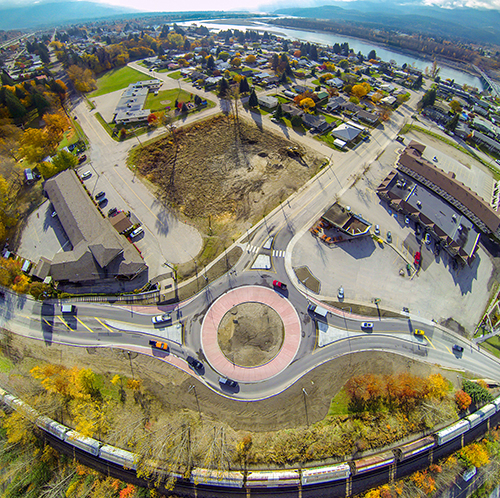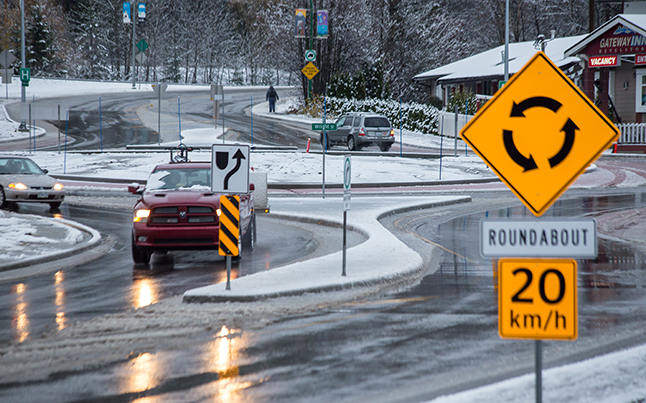Note: this is an opinion piece from a person who is not in law enforcement, and the ideas contained herein are not intended to instruct. You may entertain them at your own discretion.

To signal or not to signal, that appears to be the most burning question these days with regards to the Victoria Road roundabout.
Many people feel very strongly that signalling is the answer, that it is “only common sense” and that people who don’t signal are either discourteous or downright ignorant. Posts have been flung about The Stoke List and Facebook with more detail.
And, in fact, the BC Ministry of Transportation & Infrastructure is on their side with its assessment of How To Use Roundabouts.
However, their rule to signal upon exiting is not backed up by Law, by regulations within The Motor Vehicle Act of BC. On the other hand, these rules are:
- Vehicles inside the roundabout have the right-of-way; and
- Vehicles approaching must yield until safe to enter.
With regards to signalling, The Motor Vehicle Act of BC states:

- If traffic may be affected by turning a vehicle, a person must not turn it without giving the appropriate signal;
- If a signal of intention to turn right or left is required, a driver must give it continuously for sufficient distance before making the turn to warn traffic; and
- If there is an opportunity to give a signal, a driver must not stop or suddenly decrease the speed of a vehicle without first giving the appropriate signal.
Some might think Section 170 pertains to vehicles exiting a roundabout; however, it doesn’t appear to.
In essence, Section 170’s main purpose is to ensure that drivers are not surprised by a sudden turn of the vehicle in front of them.

Roundabout traffic is not seen to be “affected” by a vehicle exiting the traffic circle because:
- Incoming traffic must already yield to traffic within the circle and must not enter until safe to do so, even if the oncoming vehicle is signalling right;
- The distance between passing one exit and approaching the next exit is not sufficient distance within which to signal “continuously;” and if
- Traffic speed is already dramatically reduced in a roundabout.
The most important thing to realize and understand is that if someone is signalling their exit from the roundabout and you subsequently enter and crash into them, either because they turn off their signal at the last moment remembering they don’t actually want to turn off yet or just keep going because they accidentally signalled, you are still in the wrong because you entered the roundabout while it was unsafe to do so. You may or may not be 100% at fault, but you most definitely will be at fault in the eyes of the law. With the snow and ice here, this is an even more imperative distinction to make.
In some ways, with a single-lane roundabout, it could be argued that people might actually be safer if nobody signals on the exit out because then everyone is forced to do their due diligence to actually yield when approaching and entering the circle (or, at least those who understand what obeying a yield sign actually entails).
On the other hand, of course letting other drivers know what you intend to do in a traffic circle or any other traffic situation (say for instance, in another slow speed area, like a parking lot, where even fewer people signal) is always the most considerate thing to do.
In the end though, what are we losing when someone doesn’t signal their exit from a roundabout? A few precious seconds out of our lives? God forbid we actually had to stop and wait?
Maybe the actual problem is that we’re all in far too much of a rush to get where we’re going (including me) in the first place?
I’d say the best answer for our roundabout woes is for everyone to just slow down, be courteous, and simply drive safe.

- PS: There are a couple of pet-peeves floating out there that a great deal of Revelstokians do which appear to have a greater potential for tragedy:
- Extra-wide turns when leaving the road they’re on so they can cut the corner. Unbeknownst to many, most ½ tons don’t even need the extra clearance, let alone cars. Head-on collisions aren’t pretty; and
- Passing cars on the right-hand side without slowing down (even better, one should stop before proceeding). If a kid is crossing in front, you won’t see that little one until it’s too late.
Jason Portras makes photographs for The Revelstoke Current



